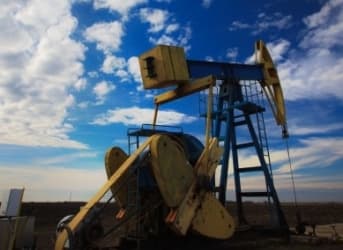Just last week I wrote on the possibility of a renewed downturn in oil prices, owing to the fact that huge volumes of supplies could potentially come online in places like Iraq, Libya, and Iran. That is still the case.
But let’s look at the other side of the coin. Despite the surprising resilience of U.S. shale, production could be now entering an extended period of decline. The EIA predicts that output in the major shale regions could decline by 91,000 barrels per day in July.
An ongoing and deeper contraction is likely. The EIA also reports a dramatic decline in well completions since October of last year. When prices starting falling, especially after the November 2014 OPEC meeting, rig counts started vanishing from the field and drilling companies began completing fewer wells.
(Click to enlarge)
That is important because shale wells suffer from rapid decline rates in their production profiles. After about the first year, the initial burst of oil largely peters out, and the decline rate is precipitous. As a result, a large number of fresh wells need to constantly be completed just to keep output flat. Related: Global Oil Production Substantially Lower Than Believed
With the number of well completions down, falling production from wells that were drilled in the past start to become more obvious. This “legacy decline” is now overtaking new production, most likely forcing overall net production to have dipped into negative territory in May.
(Click to enlarge)
The volume of legacy declines will only increase as it will increasingly reflect the huge volume of production that came online in 2013 and 2014. All of that recent production won’t be replaced as drillers sit on the sidelines. That means the decline in total production will only accelerate in the months ahead. Related:Peak Oil: Myth Or Coming Reality?
To be sure, some of the decline will be offset by the backlog of wells that have been drilled but not completed. This “fracklog” could be as large as 2,000 to 4,000 wells. That could result in hundreds of thousands of barrels of oil per day in production, the EIA predicts. Much of that could come online as prices rise, keeping production from falling too far.
On the other hand, there is also the possibility that the EIA has been overestimating U.S. production for quite some time. With state level data showing production declines in Texas and North Dakota having taken place months ago, the EIA’s estimate that production continued to rise until May could be overstating things. It is difficult to get an accurate picture of what is going on in the oil patch in real time, as so much of the published data relies on surveying and extrapolation. That data is subsequently revised as time passes, with the picture only really becoming clear months later.
Consequently, production could actually be a lot lower today than we think, meaning the overall supply and demand picture could actually be tighter than it currently appears. As the markets digest this information, prices could rise a bit. Of course, that would only set off a new round of drilling, again capping the potential gains. Related: The Dark Side Of The Shale Bust
But of course, a lot hinges on what happens in places that are not driven by such market forces. As I said last week, Iraq, Libya, and Iran could entirely overwhelm the varying scenarios in North Dakota or Texas. If those countries manage to collectively boost output by 1 million barrels per day or more, that would crash prices, even if revised EIA data reveals a sharper contraction in U.S. shale.
ADVERTISEMENT
Indeed, in the near term, that is almost certainly the case. What happens in the Middle East will have an enormous impact on the oil markets. And of course, the outcome of the Iran negotiations, with a deadline set for June 30, is the most important factor of all. That will be the most influential variable affecting oil markets, at least for the next few weeks.
By Nick Cunningham Of Oilprice.com
More Top Reads From Oilprice.com:
- Why The Oil Rally May Well Be Over
- Peak Oil: Myth Or Coming Reality?
- Top Three Rebound Stocks In The Permian Shale





















I do agree that the EIA has overstated U.S. production. Most of these shale oil producers are heavily indebted and the hedges are coming off. Get set for a major league crash of U.S. oil producers.